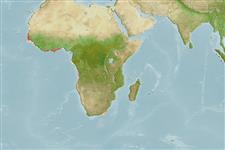Élasmobranches (requins et raies) (sharks and rays) >
Rajiformes (Skates and rays) >
Rajidae (Skates)
Etymology: Raja: Latin, raja, -ae = a sting ray (Raja sp.) (Ref. 45335); parva: Name from Latin word 'parva' meaning small, referring to the small adult size of this skate compared to most of its congeners..
Environment: milieu / climate zone / depth range / distribution range
Écologie
marin benthopélagique; profondeur ? - 27 m (Ref. 110364). Tropical
Distribution
Pays | Zones FAO | Écosystèmes | Occurrences | Point map | Introductions | Faunafri
Eastern Central Atlantic: known from Liberia, Senegal (Dakar) and Angola; probably more widspread.
Taille / Poids / Âge
Maturity: Lm ? range ? - ? cm
Max length : 37.1 cm TL mâle / non sexé; (Ref. 110364); 41.1 cm TL (female)
Description synthétique
Morphologie | Morphométrie
This species is distinguished by the following set of characters: subcircular disc, its width 57-60% TL, 1.2 times its length; snout angle 91-96°; short tail, its length 1.2-1.4 times distance from snout tip to rear of cloaca; narrow tail, its width 1.2-1.3 times height at its midlength, 1.1 times at first dorsal-fin origin; pre-upper jaw length 10-13% TL, 1.5-1.8 times internasal width; length of ventral head 24-26% TL; length of snout 3-3.8 times interorbital width; orbit diameter 1.06-0.99 times the interorbital width; height of first dorsal-fin 3.4-3.9 in its base length; procaudal tail long, its length from first dorsal-fin origin to tail tip is 3.8-4.7 times first dorsal-fin base length, 3.4-3.6 times caudal-fin length (base of epichordal lobe of caudal fin very long); relatively short pelvic fins, length of posterior lobe 17-18% TL and of anterior lobe 63-72% of posterior lobe; in adults clasper relatively large, ~24% TL, connected to pelvic-fin inner margin at ~47% of its length from cloaca; anterior margin of head possess denticle bands on both surfaces in adult male; nuchal thorns 2; adult male with well-developed malar thorn patch; thorn rows on tail 3-5; pectoral-fin radials 79-81 in total; trunk centra is usually 27-28; usually 75-86 predorsal centra; total centra ~128-131; 38-46 tooth rows in upper jaw; colour brown dorsally with faint lighter and darker speckling; pectoral ocelli is moderately large, with dark bluish grey spot surrounded by a black and a yellow ring; its ventral surface whitish with reddish yellow snout tip and disc margin (Ref. 110364).
Unknown depth range but probably inshore for at least some collected specimens were caught by gill-net (Ref. 110364).
Life cycle and mating behavior
Maturité | Reproduction | Frai | Œufs | Fécondité | Larves
Last, P.R. and B. Séret, 2016. A new Eastern Central Atlantic skate Raja parva sp. nov. (Rajoidei: Rajidae) belonging to the Raja miraletus species complex. Zootaxa 4147(4):477-489. (Ref. 110364)
Statut dans la liste rouge de l'IUCN (Ref. 130435)
Menace pour l'homme
Harmless
Utilisations par l'homme
Plus d'informations
PaysZones FAOÉcosystèmesOccurrencesIntroductionsStocksÉcologieRégime alimentaireÉléments du régime alimentaireConsommation alimentaireRation
Noms communsSynonymesMétabolismePrédateursÉcotoxicologieReproductionMaturitéFraiRassemblement de ponteFéconditéŒufsDéveloppement de l'œuf
Taille/ÂgeCroissanceLongueur-poidsLongueur-longueurFréquences de longueursMorphométrieMorphologieLarvesDynamique des populations larvairesRecrutementAbondanceBRUVS
RéférencesAquacultureProfil d'aquacultureSouchesGénétiqueElectrophoresesHéritabilitéPathologiesTraitementNutrientsMass conversion
CollaborateursImagesStamps, Coins Misc.SonsCiguateraVitesseType de nageSurface branchialeOtolithesCerveauxVision
Outils
Articles particuliers
Télécharger en XML
Sources Internet
Estimates based on models
Phylogenetic diversity index (Ref.
82804): PD
50 = 0.5000 [Uniqueness, from 0.5 = low to 2.0 = high].
Bayesian length-weight: a=0.01000 (0.00244 - 0.04107), b=3.04 (2.81 - 3.27), in cm total length, based on all LWR estimates for this body shape (Ref.
93245).
Niveau trophique (Ref.
69278): 3.6 ±0.6 se; based on size and trophs of closest relatives
Résilience (Ref.
120179): Faible, temps minimum de doublement de population : 4,5 à 14 années (Preliminary low fecundity).
Fishing Vulnerability (Ref.
59153): Low to moderate vulnerability (31 of 100).
